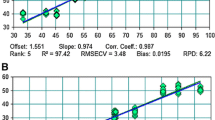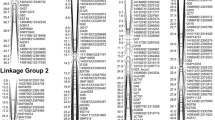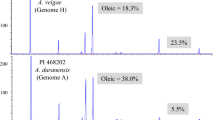Abstract
Sunflower (Helianthus annuus L.) seed oil with high palmitic acid content has enhanced thermo-oxidative stability, which makes it well suited to high-temperature uses. CAS-5 is a sunflower mutant line that accumulates over 25 % palmitic acid in its seed oil, compared to 5–8 % in conventional cultivars. The objective of this study was to investigate the molecular basis of the high-palmitic acid trait in CAS-5 through both candidate gene and QTL mapping approaches. An F2 population derived from the cross between CAS-5 and the conventional line HA-89 was developed. A 3-ketoacyl-ACP synthase II (KASII) locus on a telomeric region of linkage group (LG) 9 of the sunflower genetic map was found to co-segregate with palmitic acid content in this population. The KASII locus explained the vast majority of the phenotypic variation (98 %) of the trait. Two minor QTL affecting palmitic acid content were also found on the lower half of LG 9 and on LG 17. Additionally, QTL associated with other major fatty acids (stearic, oleic, and linoleic acid) were identified on LG 1, 6, and 10. This result may reflect untapped genetic variation that could exist among sunflower cultivars for genes determining fatty acid composition. In addition to demonstrating the major role of a KASII locus in the accumulation of high levels of palmitic acid in CAS-5 seeds, this study stressed the importance of characterizing genes with minor effects on fatty acid profile in order to establish optimal breeding strategies for modifying fatty acid composition in sunflower seed oil.


Similar content being viewed by others
References
Aghoram K, Wilson RE, Burton JW, Dewey RE (2006) A mutation in a 3-keto-acyl-ACP synthase II gene is associated with elevated palmitic acid levels in soybean seeds. Crop Sci 46:2453–2459
Anai T, Hoshino T, Imai N, Takagi Y (2012) Molecular characterization of two high-palmitic-acid mutant loci induced by X-ray irradiation in soybean. Breed Sci 61:631–638
Berry ST, Allen RJ, Barnes SR, Caligari PDS (1994) Molecular analysis of Helianthus annuus L. 1. Restriction length polymorphism between inbred lines of cultivated sunflower. Theor Appl Genet 89:435–441
Berry ST, Leon AJ, Hanfrey CC, Challis P, Burkholz A, Barnes SR, Rufener GK, Lee M, Caligari PDS (1995) Molecular marker analysis of Helianthus annuus L. 2. Construction of an RFLP linkage map for cultivated sunflower. Theor Appl Genet 91:195–199
Boersma JG, Ablett GR, Grainger C, Gillman JD, Bilyeu KD, Rajcan I (2012) New mutations in a delta-9-stearoyl-ACP desaturase gene associated with enhanced stearic acid levels in soybean seed. Crop Sci 52:1736–1742
Bohn M, Khairallah MM, González-de-León D, Hoisington DA, Utz HF, Deutsch JA, Jewell DC, Mihm JA, Melchinger AE (1996) QTL mapping in tropical maize: I. Genomic regions affecting leaf feeding resistance to sugarcane borer and other traits. Crop Sci 36:1352–1361
Bowers JE, Bachlava E, Brunick RL, Rieseberg LH, Knapp SJ, Burke JM (2012) Development of a 10,000 locus genetic map of the sunflower genome based on multiple crosses. G3 2:721–729
Burke JM, Knapp SJ, Rieseberg LH (2005) Genetic consequences of selection during the evolution of cultivated sunflower. Genetics 171:1933–1940
Cahoon EB, Shanklin J (2000) Substrate-dependent mutant complementation to select fatty acid desaturase variants for metabolic engineering of plant seed oils. Proc Natl Acad Sci USA 97:12350–12355
Cardinal AJ, Burton JW, Camacho-Roger AM, Yang JH, Wilson RF, Dewey RE (2007) Molecular analysis of soybean lines with low palmitic acid content in the seed oil. Crop Sci 47:304–310
Cardinal AJ, Whetten R, Wang S, Auclair J, Hyten D, Cregan P, Bachlava E, Gillman J, Dewey R, Upchurch G, Miranda L, Burton JW (2014) Mapping the low palmitate fap1 mutation and validation of its effects in soybean oil and agronomic traits in three soybean populations. Theor Appl Genet 127:97–111
Carlsson AS, LaBrie ST, Kinney AJ, von Wettstein-Knowles P, Browse J (2002) A KAS2 cDNA complements the phenotypes of the Arabidopsis fab1 mutant that differs in a single residue bordering the substrate binding pocket. Plant J 29:761–770
De Vries BD, Fehr WR, Welke GA, Dewey RE (2011a) Molecular analysis of mutant alleles for elevated palmitate concentration in soybean. Crop Sci 51:2554–2560
De Vries BD, Fehr WR, Welke GA, Dewey RE (2011b) Molecular characterization of the mutant (A22) allele for reduced palmitate concentration in soybean. Crop Sci 51:1611–1616
Doerge RW, Churchill GA (1996) Permutation tests for multiple loci affecting a quantitative character. Genetics 142:285–294
Dorrell DG, Vick BA (1997) Properties and processing of oilseed sunflower. In: Schneiter AA (ed) Sunflower production and technology. Agronomy monograph 35. ASA, CSSA and SSSA, Madison WI EE.UU, pp 709–746
Fernández-Martínez JM, Osorio J, Mancha M, Garcés R (1997) Isolation of high palmitic mutants on high oleic background. Euphytica 97:113–116
Fernández-Martínez JM, Velasco L, Pérez-Vich B (2004) Progress in the genetic modification of sunflower oil quality. In: Seiler GJ (ed) Proceedings of 16th international sunflower conference, Fargo, ND, USA. Int Sunflower Assoc, Paris, France, pp 1–14
Fernández-Martínez JM, Pérez-Vich B, Velasco L (2009) Mutation breeding for oil quality improvement in sunflower. In: Shu QY (ed) Induced plant mutations in the genomics era. Food and Agriculture Organization of the United Nations, Rome, pp 177–181
Garcés R, Mancha M (1993) One-step lipid extraction and fatty acid methyl esters preparation from fresh plant tissues. Anal Biochem 211:139–143
Gillman JD, Tetlow A, Hagely K, Boersma JG, Cardinal A, Rajcan I, Bilyeu K (2014) Identification of the molecular genetic basis of the low palmitic acid seed oil trait in soybean mutant line RG3 and association analysis of molecular markers with elevated seed stearic acid and reduced seed palmitic acid. Mol Breed 34:447–455
Guinda Á, Dobarganes MC, Ruiz-Mendez MV, Mancha M (2003) Chemical and physical properties of a sunflower oil with high levels of oleic and palmitic acids. Eur J Lipid Sci Technol 105:130–137
Hawkins DJ, Kridl JC (1998) Characterization of acyl-ACP thioesterases of mangosteen (Garcinia mangostana) seed and high levels of stearate production in transgenic canola. Plant J 13:743–752
Head K, Galos T, Fang Y, Hudson K (2012) Mutations in the soybean 3-ketoacyl-ACP synthase gene are correlated with high levels of seed palmitic acid. Mol Breed 30:1519–1523
Hongtrakul V, Slabaugh MB, Knapp SJ (1998) RFLP, SSCP, and SSR markers for delta 9-stearoyl-acyl carrier protein desaturases strongly expressed in developing seeds of sunflower: intron lengths are polymorphic among elite inbred lines. Mol Breed 4:195–203
Ivanov P, Petakov D, Nikolova V, Pentchev E (1988). Sunflower breeding for high palmitic acid content in the oil. In: Proceedings of 12th international sunflower conference Novi Sad, Yugoslavia, Int Sunflower Assoc, Paris, France, pp 463–465
Jones P, Davies HM, Voelker TA (1995) Palmitoyl-acyl carrier protein (ACP) thioesterase and the evolutionary origin of plant acyl-ACP thioesterases. Plant Cell 7:359–371
Kim HU, Huang AHC (2004) Plastid lysophosphatidyl acyltransferase is essential for embryo development in arabidopsis. Plant Physiol 134:1206–1216
Lai Z, Livingstone K, Zou Y, Church SA, Knapp JS, Andrews J, Rieseberg LH (2005) Identification and mapping of SNPs from ESTs in sunflower. Theor Appl Genet 111:1532–1544
Lander ES, Green P, Abrahamson J, Barlow A, Daly MJ, Lincoln SE, Newburg L (1987) MAPMAKER: an interactive computer package for constructing primary genetic linkage maps of experimental and natural populations. Genomics 1:174–181
Marchive C, Nikovics K, To A, Lepiniec L, Baud S (2014) Transcriptional regulation of fatty acid production in higher plants: molecular bases and biotechnological outcomes. Eur J Lipid Sci Technol 116:1332–1343
Marmesat S, Mancha M, Ruiz-Méndez MV, Dobarganes MC (2005) Performance of sunflower oil with high levels of oleic and palmitic acids during industrial frying of almonds, peanuts, and sunflower seeds. J Am Oil Chem Soc 82:505–510
Marmesat S, Velasco L, Ruiz-Méndez MV, Fernández-Martínez JM, Dobarganes C (2008) Thermostability of genetically modified sunflower oils differing in fatty acid and tocopherol compositions. Eur J Lipid Sci Technol 110:776–782
Marmesat S, Morales A, Velasco J, Dobarganes MC (2012) Influence of fatty acid composition on chemical changes in blends of sunflower oils during thermoxidation and frying. Food Chem 135:2333–2339
Martínez-Force E, Álvarez-Ortega R, Garcés R (1999) Enzymatic characterisation of high-palmitic acid sunflower (Helianthus annuus L.) mutants. Planta 207:533–538
Moreno-Pérez AJ, Venegas-Calerón M, Vaistij FE, Salas JJ, Larson TR, Garcés R, Graham IA, Martínez-Force E (2012) Reduced expression of FatA thioesterases in Arabidopsis affects the oil content and fatty acid composition of the seeds. Planta 235:629–639
Moreno-Pérez AJ, Venegas-Calerón M, Vaistij FE, Salas JJ, Larson TR, Garcés R, Graham IA, Martínez-Force E (2014) Effect of a mutagenized acyl-ACP thioesterase FATA allele from sunflower with improved activity in tobacco leaves and Arabidopsis seeds. Planta 239:667–677
O’Hara P, Slabas AR, Fawcett T (2000) Modulation of fatty acid biosynthesis by β-keto reductase expression. Biochem Soc Trans 28:613–615
O’Hara P, Slabas AR, Fawcett T (2001) Fatty acid synthesis in developing leaves of Brassica napus in relation to leaf growth and changes in activity of 3-oxoacyl-ACP reductase. FEBS Lett 488:18–22
O’Hara P, Slabas AR, Fawcett T (2007) Antisense expression of 3-oxoacyl-ACP reductase affects whole plant productivity and causes collateral changes in activity of fatty acid synthase components. Plant Cell Physiol 48:736–744
Ohlrogge JB, Jaworski JG (1997) Regulation of fatty acid synthesis. Annu Rev Plant Physiol Plant Mol Biol 48:109–136
Okuley J, Lightner J, Feldmann K, Yadav N, Lark E, Browse J (1994) Arabidopsis FAD2 gene encodes the enzyme that is essential for polyunsaturated lipid synthesis. Plant Cell 6:147–158
Osorio J, Fernández-Martínez JM, Mancha M, Garcés R (1995) Mutant sunflower with high concentration in saturated fatty acid in the oil. Crop Sci 35:739–742
Pérez-Vich B, Fernández J, Garcés R, Fernández-Martínez JM (1999) Inheritance of high palmitic acid content in the seed oil of sunflower mutant CAS-5. Theor Appl Genet 98:496–501
Pérez-Vich B, Fernández-Martinez JM, Grondona M, Knapp SJ, Berry ST (2002) Stearoyl-ACP and oleoyl-PC desaturase genes cosegregate with quantitative trait loci underlying stearic and oleic acid mutant phenotypes in sunflower. Theor Appl Genet 104:338–349
Pérez-Vich B, Fernández-Martinez JM, Leon A, Knapp SJ, Berry ST (2004a) Mapping minor QTL for increased stearic acid content in sunflower seed oil. Mol Breed 13:313–322
Pérez-Vich B, Akhtouch B, Knapp SJ, Leon AJ, Velasco L, Fernández-Martínez JM, Berry ST (2004b) Quantitative trait loci for broomrape (Orobanche cumana Wallr.) resistance in sunflower. Theor Appl Genet 109:92–102
Pidkowich MS, Nguyen HT, Heilmann I, Ischebeck T, Shanklin J (2007) Modulating seed beta-ketoacyl-acyl carrier protein synthase II level converts the composition of a temperate seed oil to that of a palm-like tropical oil. Proc Natl Acad Sci USA 104:4742–4747
Salas JJ, Martínez-Force E, Harwood JL, Venegas-Calerón M, Aznar-Moreno JA, Moreno-Pérez AJ, Ruíz-López N, Serrano-Vega MJ, Graham IA, Mullen RT, Garcés R (2014) Biochemistry of high stearic sunflower, a new source of saturated fats. Prog Lipid Res 55:30–42
Schuppert GF, Tang S, Slabaugh MB, Knapp SJ (2006) The sunflower high-oleic mutant Ol carries variable tandem repeats of FAD2-1, a seed-specific oleoyl-phosphatidyl choline desaturase. Mol Breed 17:241–256
Shimakata T, Stumpf PK (1982) Isolation and function of spinach leaf beta-ketoacyl- acyl-carrier-protein synthases. Proc Natl Acad Sci USA 79:5808–5812
Soldatov KI (1976) Chemical mutagenesis in sunflower breeding. Proceeding of 7th international sunflower conference. USSR, Krasnodar, pp 352–357
Somerville C, Browse J, Jaworski JG, Ohlrogge JB (2000) Lipids. In: Buchanan BB, Gruissem W, Jones RL (eds) Biochemistry and molecular biology of plants. Amer Soc Plant Physiol, Rockville, MD, pp 456–527
Tang S, Yu JK, Slabaugh MB, Shintani DK, Knapp SJ (2002) Simple sequence repeat map of the sunflower genome. Theor Appl Genet 105:1124–1136
Troncoso-Ponce MA, Nikovics K, Marchive C, Lepiniec L, Baud S (2015) New insights on the organization and regulation of the fatty acid biosynthetic network in the model higher plant Arabidopsis thaliana. Biochimie. doi:10.1016/j.biochi.2015.05.013
Utz HF, Melchinger AE (1996) PLABQTL: a program for composite interval mapping of QTL. J Quant Trait Loci 2:1–5
Velasco L, Pérez-Vich B, Fernández-Martínez JM (2008) A new sunflower mutant with increased levels of palmitic acid in seed oil. Helia 48:55–60
Voorrips RE (2002) MapChart: software for the graphical presentation of linkage maps and QTLs. J Hered 93:77–78
Yu JK, Tang S, Slabaugh MB, Heesacker A, Cole G, Herring M, Soper J, Han F, Chu W-C, Webb DM, Thompson L, Edwards KJ, Berry S, Leon AJ, Grondona M, Olungu C, Maes N, Knapp SJ (2003) Towards a saturated molecular genetic linkage map for cultivated sunflower. Crop Sci 43:367–387
Zeng ZB (1994) Precision mapping of quantitative trait loci. Genetics 136:1457–1468
Acknowledgments
The research was partially funded by Junta de Andalucía support program to research group AGR-118.
Author information
Authors and Affiliations
Corresponding author
Electronic supplementary material
Below is the link to the electronic supplementary material.
11032_2016_462_MOESM1_ESM.docx
Supplementary material 1 Correlation coefficients between palmitic acid, stearic acid, oleic acid, and linoleic acid levels in the F2 generation (195 individuals) from crosses between HA-89, with standard low palmitic acid content, and CAS-5, with high palmitic acid content (DOCX 42 kb)
11032_2016_462_MOESM2_ESM.docx
Supplementary material 2 Scatter plot of palmitic acid (% of the total fatty acids) versus oleic acid (% of the total fatty acids) in the HA-89 x CAS-5 F2 mapping population, labeled according to the alleles at the KASII marker locus on LG 9. A= homozygous with respect to the allele derived from CAS-5; B= homozygous with respect to the allele derived from HA-89; H= heterozygous (DOCX 77 kb)
Rights and permissions
About this article
Cite this article
Pérez-Vich, B., del Moral, L., Velasco, L. et al. Molecular basis of the high-palmitic acid trait in sunflower seed oil. Mol Breeding 36, 43 (2016). https://doi.org/10.1007/s11032-016-0462-2
Received:
Accepted:
Published:
DOI: https://doi.org/10.1007/s11032-016-0462-2




